“I like masculine and rigorous, and I like geometry and also something that is minimal, but why do I have to be boring?” he asks. “Me too, I also dress with blue jeans, but why can’t I use a flower T-shirt? I am a man, a straight guy, but also I can wear something that can be decorated, that can be more joyful.” The Dora chair reflects not only these masculine and feminine influences—Palomba shares the studio with his wife, along with ten other designers and staff—but also multi generational and multicultural design inspirations. According to Palomba, “The main idea is that you can do something rigorous or rational, but it can contain something absolutely crazy, and it can belong to the same project. So we went with this strange combination of an homage to the ’50s classical design, and this decorated skin, which is very like a Japanese kimono. Our international society is changing, so we have to find new models, and this has to be reflected in our design.”
The Dora was also the product of Palomba’s informal and friendly relationship with the manufacturer. “I have a close relationship with the company,” he says, “and we often talk about new projects. I’m very free, and when I have an idea, I go and I say, I have this idea, can we see about making it? It’s very important for me to have a very flat and very simple relationship with the clients, who are generally sometimes my friends, too. So we talk about other things, not just about jobs, and sometimes ideas come from talking about other things.” In the case of the Dora, part of Palomba’s goal was to create something new and unique. “There are hundreds of pieces in roto-molding plastic,” he points out. “The sales people were asking for something—always sales people ask for something they don’t have. And so we say, if we have to make a Zanotta piece with roto molding, it has to be totally different from what is on the market.”
From this multitude of ideas, influences, and impulses, came the Dora, with distinctive “flower tattoos.” Palomba looked at several patterns, including stripes and oversized polka dots, before settling on the natural pattern. “I can say that I was thinking of having something that looks like fabric directly on the surface. I makde some sketches, then I saw some Japanese decor, and I said that I would like to do something like that, put a kimono on a ’50s arm chair. Flowers, well, flowers are always a positive object,” he points out. The pattern is created directly in the mold itself by having some parts of the chair polished and others matte. The Dora is also available in a lacquered, highly polished version without the pattern, but Palomba prefers the “tattoos.”
The shape of the chair was designed not only as a nod to an earlier aesthetic, but also to provide optimal comfort for all-season, all-weather seating.
|
_______ |
__________________________________ 32 DESIGN SECRETS: FURNITURE |
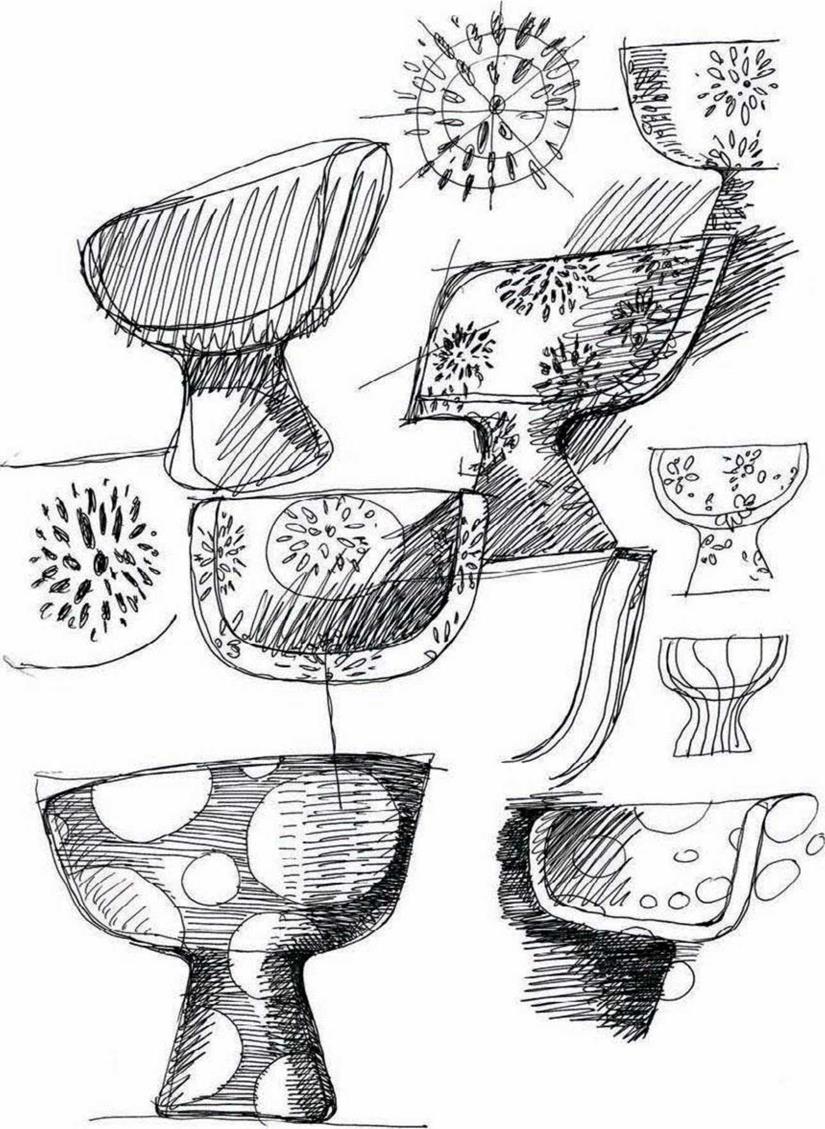
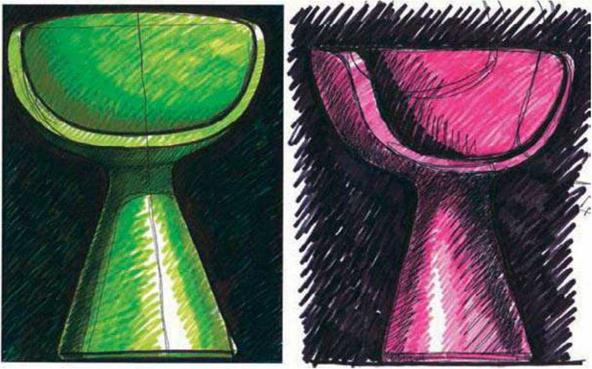 © Early sketches by Roberto Palomba show the variety of patterns he considered before settling on the flower for its inherently positive associations.
© Early sketches by Roberto Palomba show the variety of patterns he considered before settling on the flower for its inherently positive associations.
Credit: Roberto Palomba
Palomba wanted his Dora chair, which can be used inside or out, to have a fat, sensual shape, as well as harken back to design influences of the ’50s, as depicted in these early sketches.
Credit: Roberto Palomba
|
|
|
|
|
|
|
|
|
|
|
|
|
|
|
|
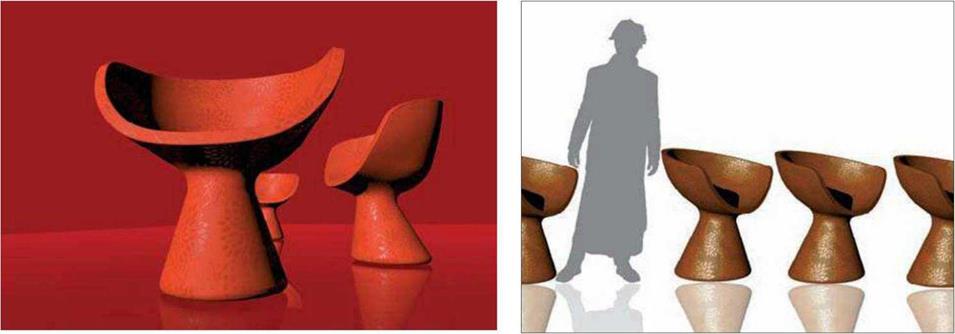

“When you make a thing in plastic, it’s a continuous shape, and you always have to think about it like a ceramic or glass object, things that can be done only in one piece,” Palomba notes. “It’s very easy when using plastic to make a soft and sensual shape. I would like it to look fat and comfortable, but, when possible, the design has to also have a good price and be very comfortable.” In addition to meeting these criteria, Palomba is pleased that the Dora is so versatile in both its pragmatism and aesthetics. “If you go around and look at this piece, the shape changes continuously,” he points out. “You have lots of points of view. And this armchair can also be put outside, in the open air.”
The chair’s comfort resulted from rigorous testing of prototypes. “We were very careful with this,” Palomba emphasizes. And also as important: nontechnical sit test. “It was very funny because in
© Top left: One of the most interesting qualities of the Dora chair is how its shape changes subtly as you move around it—as shown in this computer rendering—while it retains the essence of its inviting nature. Credit: Palomba Serafini
© Top right: Another computer rendering places the chair in human scale and shows the subtle shimmer created by the contrasting texture of the tattooed skin. Credit: Palomba Serafini
© An early prototype focuses on the dimensions that create the extremely comfortable bucket shape of the seat. The pattern of flowers is also made more apparent. Credit: Palomba Serafini
|
_______ |
__________________________________ 34 DESIGN SECRETS: FURNITURE |
the company, I discovered when they make armchairs, there is a man who is, I don’t want to say fat, but he’s a big man. When we make a model, we have to make a test with this man. When I arrive with the model, at the beginning, he arrives, and I was thinking it was a test to try and break it,” Palomba recounts with another of his frequent bursts of laughter.
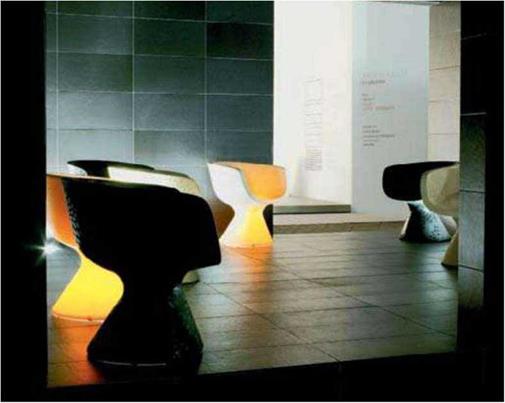
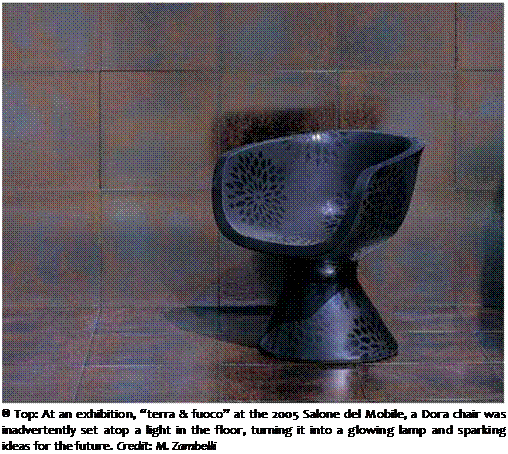
 The chair also underwent some other, completely unplanned testing at an exhibition in the Salone del Mobile. Someone unintentionally placed one of the chairs over a light in the floor, turning the Dora into an impromptu lamp. This happy accident was then repeated intentionally to create softly glowing chairs throughout the exhibition. In addition, Palomba reports, “We left some chairs at the show and the people were playing a lot with them. What was very nice was the relationship with the babies. They were playing with them, climbing up and down, or putting them on the floor and using them like a big toy or creating a little car or something with it. I see that this kind of shape attracts the baby, and this was a good test.”
The chair also underwent some other, completely unplanned testing at an exhibition in the Salone del Mobile. Someone unintentionally placed one of the chairs over a light in the floor, turning the Dora into an impromptu lamp. This happy accident was then repeated intentionally to create softly glowing chairs throughout the exhibition. In addition, Palomba reports, “We left some chairs at the show and the people were playing a lot with them. What was very nice was the relationship with the babies. They were playing with them, climbing up and down, or putting them on the floor and using them like a big toy or creating a little car or something with it. I see that this kind of shape attracts the baby, and this was a good test.”
Reflecting on the Dora chair’s development, Palomba feels that it is both a bit of a departure in execution but also a continuation of an important design concern. “I think with this object, there is something that I’ve never done before: a very strong inspiration with a classic object. Generally, we try to make objects that are more original, I would say. But I don’t feel this work is like something wrong, because the main research was to create an object that worked in this way. This is what I asked of myself in the beginning, I asked myself to do this, it was not imposed to me, it was not something that happened, it was something that I decided to do.”
 |
This is a lesson Palomba also emphasizes to his design students at the university in Milan, where he teaches. “I say always the same thing when I talk to students,” he notes. “I say that they have to think before they draw. It’s up to you, you have to dig very well inside of you and choose your own way, and you say what you really feel to say.” Thinking about the contrast between the iconic designers of the era that helped inspire his Dora chair, he notes, “In university today, they don’t want to be a designer, they want to be a famous designer. But when you are creative, you have to say what you really feel, and you can’t mind if you will be famous, because then you are just a marketing man. This hurts the younger generation. They just want to be a superstar, and this is totally mistaken. Design is something you have to take care about. We can’t make objects just to make our glory.”



